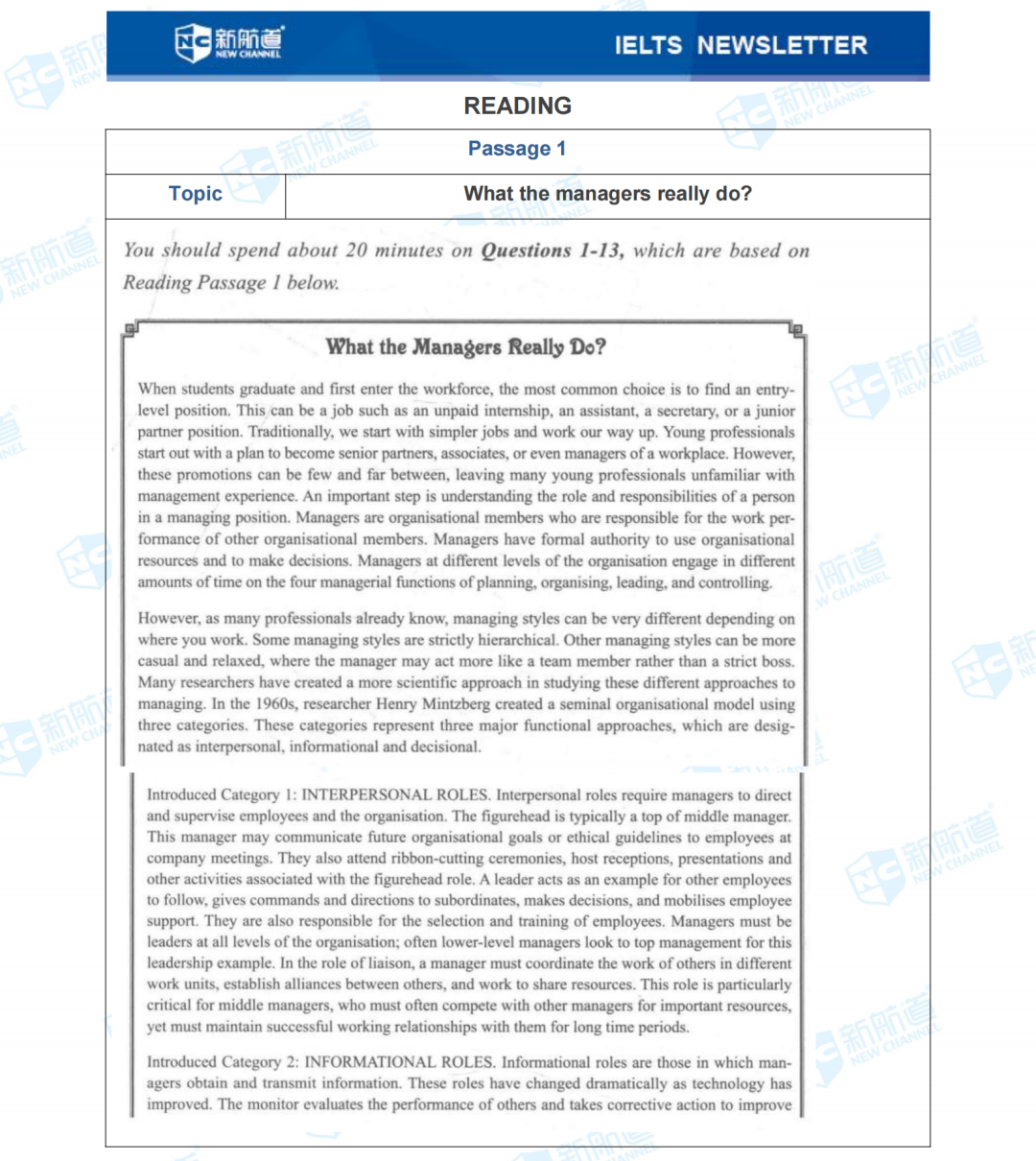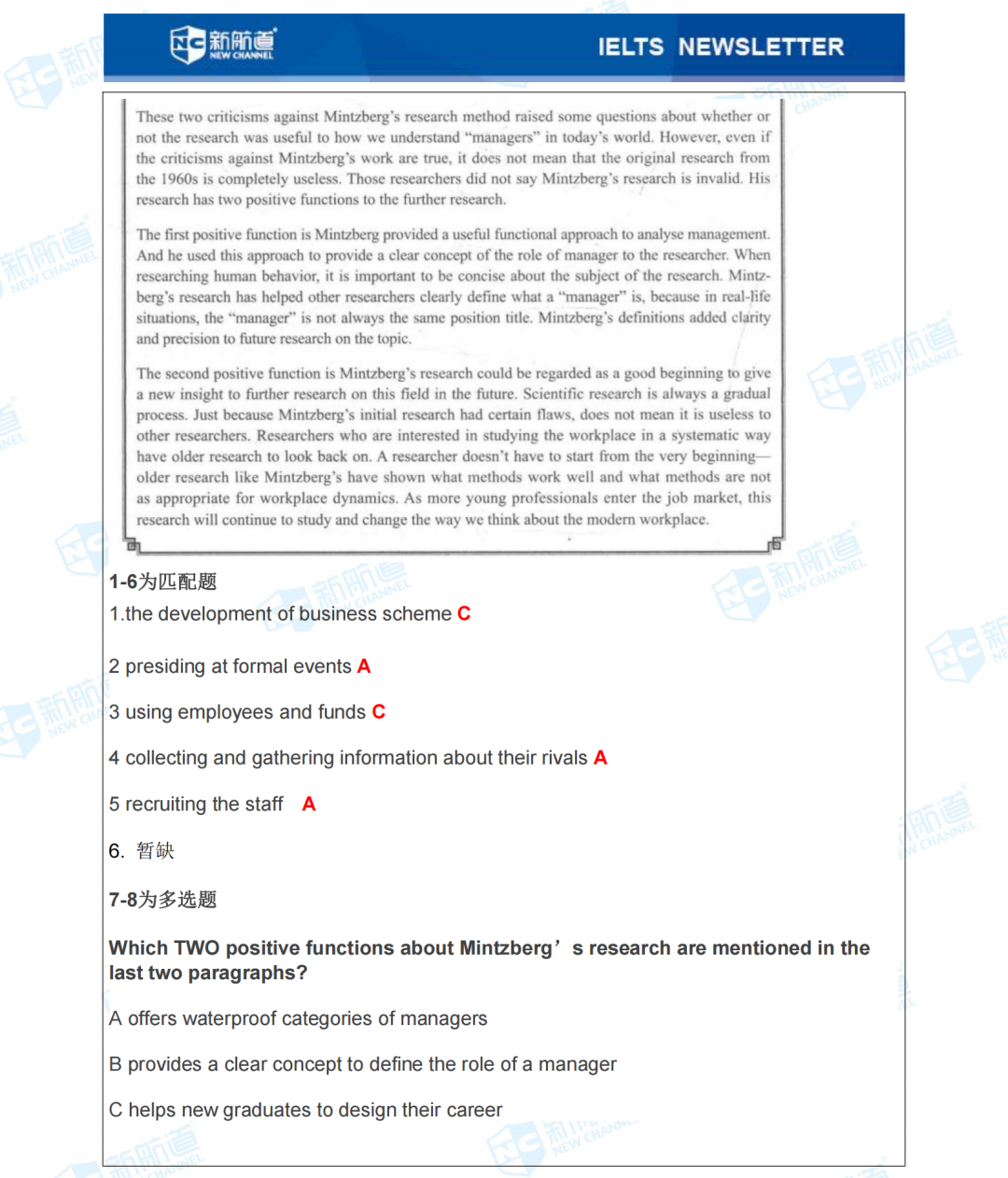2021年6月26日雅思考试阅读机经真题答案回忆【新航道版】
上海新航道雅思培训班 小编为大家整理了2021年6月26日雅思考试阅读机经真题答案回忆,每次考试后新航道雅思 小编会在1-2天内更新托福机经回忆



D suggests ways for managers to do their job better
E makes a fresh way for further research
9-13判断对错题
9 Young professionals can easily know management experience in the work place FALSE
10 Mintzberg' s theory broke well established notions about managing styles. NOT GIVEN
11 Minzberg got a large amount of research funds for his contribution NOT GIVEN
12 All managers do the same work FALSE
13 Minzberg' s theory is invalid in the future studies FALSE
Passage2
Topic
The Return of Monkeys
As an east wind blasts through a gap in the Cordile de Tilaran, a rugged mountain range the splits northern Costa Rica in half, a female mantled howler monkey moves through the
swaying trees of the forest canopy.
A Ken Glander,a primatologist from Duke University, gazes into the canopy, tracking the female's movements. Holding a dart gun, he waits with infinite patience forthe right
moment to shoot. With great care, Glander aims and fires. Hit in the rump, the monkey wobbles. This howler belongs to a population that has lived for decades at Hacienda La
Pacifica, a working catle ranch inGuanacaste province. Other native primates一 white-faced capuchin monkeys and spider monkeys - once were common in this area,
too, but vanished after the Pan-American Highway was built nearby in the 1950s. Most of the surrounding land was clear-cut for pasture.
3 Howlers persist at La Pacifica, Glander explains, because they are leaf-eaters. They eat fruit, when it's available but, unlike capuchin and spider monkeys, do not depend on
large areas of fuiling trees. Howlers can survive anyplace you have half a dozen trees, because their eating habits are so flexible',he says. In forests, life is an arms race
between trees and the myriad creatures that feed on leaves. Plants have evolved a variety of chemical defenses, ranging from bad-tasting tannins, which bind with plant-produced
nutrients, rendering them indigestible, to deadly poisons, such as alkaloids and cyanide.
C All primates, including humans, have some ability to handle plant toxins. "We can detoxifty a dangerous poison known ascaffeine, which is deadly to a lot of animals:" Glander says. For leaf-eaters, long-term exposure to a specific plant toxin can increase their ability to defuse the poison and absorb the leaf nutrients. The leaves that grow in regenerating forests, like those at La Paifica, are actually more hower friendly than those produced by the undisturbed, centuries-old trees that surive farther south, in the Amazon Basin. In younger forests, trees put most of their limited energy into growing wood, leaves and fruit, so they produce much lower levels of toxin than do well established, old-growth trees.
The value of matuing forests to primates is a subject of study at Santa Rosa National Park, about 35 miles northwest of Hacienda La Pacifica. The park hosts populations not only of mantled howlers but also of white -faced capuchins and spider monkeys. Yet the forests there are young, most of them less than 50 years old. Capuchins were the frst to begin using the rebom forests, when the trees were as young as 14 years. Howlers, larger and heavier than capuchins, need somewhat older trees, with limbs that can support their greater body weight. A working ranch at Hacienda La Pacifica also explain their population boom in Santa Rosa. "Howlers are more resilient than capuchins and spider monkeys for several reasons," Fedigan explains. "They can live within a small home range, as long as the trees have the right food for them. Spider monkeys, on the other hand, occupy a huge home range, so they can't make it in fragmented habitat."
E Howlers also reproduce faster than do other monkey species in the area. Capuchins don't bear their first young until about 7 years old, and spider monkeys do so even later, but howlers give birth for the first time at about 3.5 years of age. Also, while afemale spider monkey will have a baby about once every four years, well-fed howlers can produce an infant every two years.
F The leaves howlers eat hold plenty of water, so the monkeys can survive away from open streams and water holes. This ability gives them a real advantage over capuchin and spider monkeys, which have suffered during the long, ongoing drought in Guanacaste.
G Growing human population pressures in Central and South America have led to persistent destruction of forests. During the 1990s, about 1.1 million acres of Central American forest were flld yearly. Alejandro Estrada, an ecologist at Estacion de Biologia Los Tuxtlas in Veracruz, Mexico, has been exploring how monkeys suvive in a landscape increasingly shaped by humans. He and his colleagues recenty studied the ecology of a group of mantled hower monkeys that thrive in a habitat completely atered by humans: a cacao plantation in Tabasco, Mexico. Like many varieties of coffee, cacao plants need shade to grow. so 40 years ago the landowners planted fg, monkey pod and other tall trees to form a protective canopy over their crop. The howlers moved in about 25 years ago after nearby forests were cut. This strange habitat, a hodgepodge of cultivated native and exotic plants, seems to support about as many monkeys as would a same-sized patch of wild forest. The howlers eat the leaves and fruit of the shade trees, leaving the valuable cacao pods alone, so the farmers tolerate them.
Estrada believes the monkeys bring underappreciated benefits to such farms,dispersing the seeds of fig and other shade trees and frilizing the soil with feces. He points out that howler monkeys live in shade coffee and cacao plantations in Nicaragua and Costa Rica as well as in Mexico. Spider monkeys also forage in such plantations, though they need nearby areas of forest to survive in the long term. He hopes that farmers will begin to see the advantages of assciating with wild monkeys, which includes potential .
ecotourism projects.
"Conservation is usually viewed as a conflict between agricultural practices and the need to preserve nature," Estrada says. "We 're moving away from that vision and beginning to
consider ways in which agricultural ativities may become a tool for the conservation of primaltes in human-modifled landscapes."
14-19段落配对题
14. A reference of rate of reduction in forest habitats G
15. An area where only one species of monkey survived while other two species vanished. A
16. A reason for hower monkeys to choose new leaves as food over old ones C
17. Mention of howler monkey's diet and eating habits。 B
18. A reference of asking farmers to change ttitude towards wildlife H
19 The advantage of hower monkey's fexibility in living in a segmented habitat D
20-22为单选题
20. C
21. A
22. B
23-26填空题
23.reproduction
24.plant toxin/ toxin
25.water
26.drought
Passage 3
Topic
The beginning of modern cognition
Archaeologists excavating a cave on the coast of South Africa not long ago unearthed an unusual abalone shell. Inside was a rusty red substance. After analyzing the mixture and nearby stone grinding tools, the researchers realized they had found the world's eariest known paint, made 100,000 years ago from charcoal, crushed animal bones, iron-ich rock and an unknown liquid. The abalone shell was a storage container- -a prehistoric paint can.
The find revealed more than just the fact that people used paints so long ago. It provided a peek into the minds of early humans. Combining materials to create a product that doesn't
resemble the original ingredients and saving the concoction for later suggests people at the time were capable of abstract thinking. innovation and planning for the future.
These are among the mental abilties that many anthropologists say distinguished humans, Homo sapiens, from other hominids. Yet researchers have no agreed-upon defnition o
exacty what makes human cognition s0 special.
"It's hard enough to tell what the cognitive abilties are of somebody who's standing in front of you," says Alison Brooks, an archaeologist at George Washington University and the
Smithsonian Institution in Washington, D.C.“So it's really hard to tell for someone who's been dead for half a million years or a quarter million years."
Since archaeologists can't administer psychological tests to eartly humans, they have to examine artifacts left behind. When new technologles or ways of living appear in the archaeological record, anthropologists try to determine what sort of novel thinking was required to fashion a spear, say, or mix paint or collect shellish. The past decade has been particulartly futful for finding such evidence. And archaeologists are now piecing together the pattems of behavior recorded in the archaeological record of the past 200,000 years to reconstruct the trajectory of how and when humans started to think and act like modem people.
There was a time when they thought they had it all figured out. In the 1970s, the consensus was simple: Modem cognition evolved in Europe 40.000 years ago, That's when cave art, jewelry and sculpted figurines all seemed to appear for the first time. The art was a sign that humans could use symbols to represent their world and themselves, archaeologists reasoned, and therefore probably had language, too. Neanderthals living nearby didn't appear to make art, and thus symbolic thinking and language formed the dividing line between the two species' mental abilities. (Today, archaeologists debate whether, and to what degree, Neanderthals were symbolic beings,)
One problem with this analysis was that the earliest fossils of modem humans came from Africa and dated to as many as 200.000 years ago- -roughly 150,000 years before people
were depicting bison and horses on cave walls in Spain. Richard Klein, a paleoanthropologist at Stanford University, suggested that a genetic mutation ocurred 40,000 years ago and caused an abrupt revolution in the way people thought and behaved.
In the decades fllowing. however, archaeologists working in Africa brought down the notion that there was a lag between when the human body evolved and when modern thinking emerged.“As researchers began to more intensely investigate regions outside of Europe, the evidence of symbolic behavior got older and older," says archaeologist April Nowell of the University of Victoria in Canada.
For instance, artifacts recovered over the past decade in South Africa- such as pigments made from red ochre, perforated shell beads and ostrich shells engraved with geometric designs- have pushed back the origins of symbolic thinking to more than 70,000 years ago, and in some cases, to as early as 164.000 years ago. Now many anthropologists agree that modem cognition was probably in place when Homo sapiens emerged.
"It always made sense that the origins of moderm human behavior, the full assembly of modem uniqueness, had to occur at the origin point of the lineage," says Curtis Marean, a
paleoanthropologist atArizona State University in Tempe.
Marean thinks symbolic thinking was a crucial change in the evolution of the human mind. "When you have that, you have the ability to develop language. You have the ability to
exchange recipes of technology," he says. It also aided the formation of extended, long-distance social and trading networks, which other hominids such as Neanderthals lacked. These advances enabled humans to. spread into new, more complex envirnments, such as coastal locales, and eventually across the entire planet.“The world was their oyster," Marean says.
But symbolic thinking may not account for all of the changes in the human mind, says Thomas Wynn, an archaeologist at the University of Colorado. Wynn and his colleague,
University of Colorado psychologist Frederick Coolidge, suggest that advanced "working memory" was the final critical step toward modern cognition.
Working memory alows the brain to retrieve, process and hold in mind several chunks of information all at one time to complete a task. A particularly sophisticated kind of working
memory "involves the ability to hold something in attention while you'e being distracted," Wynn says. In some ways, it's kind of like multitasking. And it's needed in problem solving,
strategizing, innovating and planning. In chess, for example, the brain has to keep track of the pieces on the board, anticipate the opponent's next several steps and prepare (and
remember) countermoves for each possible outcome.
Finding evidence of this kind of cognition is challenging because humans don't use advanced working memory all that much. "It requires a lot of ffort," Wynn says.“1f we don't have to use it, we don't." Instead, during routine tasks, the brain is sort of on autopilot, like when you drive your car to work. You're not really thinking about it. Based on frequency alone, behaviors requiring working memory are less liely to be preserved than common activities that don't need it, such as making simple stone choppers and handaxes.
Yet there are artifacts that do seem to relate to advanced working memory. Making tools composed of separate pieces, like a hatted spear or a bow and arrow, are examples that date to more than 70,000 years ago. But the most convincing example may be animal traps, Wynn says.At South Africa's Sibudu cave, Lyn Wadley, an archaeologist at the University of the Witwatersrand, has found clues that humans were hunting large numbers of small, and sometimes dangerous, forest animals, including bush pigs and diminutive antelopes called blue duikers. The only plausible way to capture such citers was with snares and traps.
With a trap, you have to think up a device that can snag and hold an animal and then return later to see whether it worked. That's the kind of thing working memory does for us," Wynn
says. "It allows us to work out those kinds of problems by holding the necessary information in mind."
It may be too simple to say that symbolic thinking, language or working memory is the single thing that defines modem cognition, Marean says. And there still could be important
components that haven't yet been identifled. What's needed now, Wynn adds, is more experimental archaeology. He suggests bringing people into a psych lab to evaluate what cognitive processes are engaged when participants make and use the tools and technology of early humans.
Some see a slow progression in the accumulation of knowledge, while others see modern behavior evolving in fts and starts. Archaeologist Franceso d'Erico of the Universitly of Bordeaux in France suggests certain advances show up early in the archaeological record only to disappear for tens of thousands of years before these behaviors for whatever reason- get permanently incorporated into the human repertoire about 40.000 years ago.
It's probably due to climatic changes, environmental vaiability and population size,d'Erico says. He notes that several tool technologies and aspects of symbolic expression, such as
pigments and engraved artifacts, seem to disappear after 70,000 years ago. The timing coincides with a global cold spell that made Africa drier. Populations probably dwindled and fragmented in response to the climate change. Innovations might have been lost in a prehistoric version of the Dark Ages. And various groups probably reacted in different ways depending on cultural variation, d'Emrico says.“Some cultures for example are more open to innowation."
Perhaps the best way to settle whether the buildup of modern behavior was steady or punctuated is to find more archaeological sites to fl in the gaps. There are only a handful of sites, for example, that cover the beginning of human history. "We need those [sites] that date between 125.000 and 250,000 years ago," Marean says. "That's really the sweet spot."
27-30 判断对错题
27. As soon as they saw the materials, archaeologists were aware what they have found near the cave.N
28. The ingredients of mixture in paint are interesting for early humans to use.NG
29. There was some doubt among researchers about findings.Y
30. There was a decline in the number of things that were found.N
31-34 多选题
31. The writer mentions findings in order to llustrate tool maker' s D
A hunting ability
B communication skills
C artistic creativity
D forward planning
32. The writer emphasizes the importance of artefact to A
A. show how innowative the early people were
B. know how primitive societies formed
C. establish what they found
D. ascertain the materials that were available to early humans
33. The writer used "animal trap" as example to ilustrate C
A the dificulty of hunting animals
B. the importance of tools
C. the ability of puting data pieces together
34. What was described about the development of modern behavior? A
A. different opinions
35-40 匹配题
35. Alison Brooks described-- C
36. Richard Klein believed-- A
37. April Nowell thought-- F
38. Curtis Marean described-- D
39. Thomas Wynn disputed-G
40. Franceso d' Errico mentioned-E
A. a sudden change in how people’ s mind was evolved.
B. human thinking altered because of using tools.
C. challnges in finding the way of thinking of early humans.
D. signifcant impact of symbolic thinking.
E. disappearance of certain development due to some reasons.
F. symbolic thinking evolved earlier than assumed.
G. symbolic thinking was solely responsible for the change in human mind.









